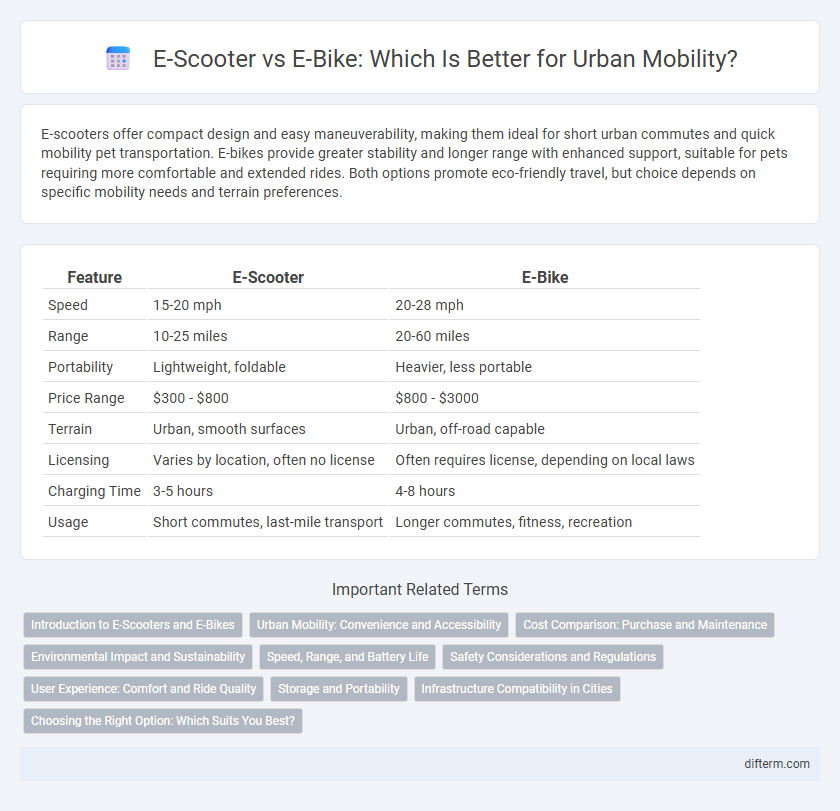E-scooters offer compact design and easy maneuverability, making them ideal for short urban commutes and quick mobility pet transportation. E-bikes provide greater stability and longer range with enhanced support, suitable for pets requiring more comfortable and extended rides. Both options promote eco-friendly travel, but choice depends on specific mobility needs and terrain preferences.
Table of Comparison
| Feature | E-Scooter | E-Bike |
|---|---|---|
| Speed | 15-20 mph | 20-28 mph |
| Range | 10-25 miles | 20-60 miles |
| Portability | Lightweight, foldable | Heavier, less portable |
| Price Range | $300 - $800 | $800 - $3000 |
| Terrain | Urban, smooth surfaces | Urban, off-road capable |
| Licensing | Varies by location, often no license | Often requires license, depending on local laws |
| Charging Time | 3-5 hours | 4-8 hours |
| Usage | Short commutes, last-mile transport | Longer commutes, fitness, recreation |
Introduction to E-Scooters and E-Bikes
E-scooters and e-bikes represent two popular electric micro-mobility options transforming urban transportation. E-scooters are lightweight, compact vehicles ideal for short-distance trips with speeds typically ranging from 15 to 20 mph. E-bikes combine the traditional bicycle design with electric pedal assistance, offering extended range and versatility for commuting and recreational use.
Urban Mobility: Convenience and Accessibility
E-scooters offer compact design and lightweight features, making them highly convenient for short urban trips and easy to park or store in crowded city spaces. E-bikes provide extended range and greater stability, accommodating longer commutes and diverse terrains, enhancing accessibility for varied urban environments. Both modes integrate seamlessly with public transportation, promoting efficient, multimodal urban mobility solutions.
Cost Comparison: Purchase and Maintenance
E-scooters typically have a lower initial purchase price, averaging between $300 and $700, compared to e-bikes which range from $800 to $3,000 based on features and brand. Maintenance costs for e-scooters are generally lower due to fewer mechanical components, averaging around $50 to $150 annually, whereas e-bike upkeep can cost $150 to $300 yearly because of more complex parts like gears and chains. Battery replacement costs affect both modes, with e-bike batteries ranging from $300 to $700 and e-scooter batteries costing between $150 and $400.
Environmental Impact and Sustainability
E-scooters generally produce lower carbon emissions per mile compared to e-bikes due to their smaller motors and lighter weight, making them a more eco-friendly option for short urban trips. However, e-bikes offer greater sustainability through longer lifespans and higher energy efficiency during longer commutes, reducing overall battery waste and resource consumption. Lifecycle assessments reveal that while e-scooters excel in first-mile/last-mile transport, e-bikes contribute more significantly to reducing car dependency and urban air pollution.
Speed, Range, and Battery Life
E-scooters typically reach speeds of 15-20 mph, while e-bikes can exceed 28 mph, offering faster urban commuting options. E-bikes provide greater range, often between 40-70 miles per charge, compared to e-scooter ranges of 15-30 miles, making e-bikes more suitable for longer trips. Battery life in e-bikes tends to be more robust, with capacities ranging from 400Wh to 700Wh, whereas e-scooter batteries usually range from 200Wh to 350Wh, impacting overall performance and durability.
Safety Considerations and Regulations
E-scooters often face stricter regulations regarding helmet use and speed limits due to higher accident rates compared to e-bikes, which benefit from more stable designs and integrated lighting systems. E-bike riders generally experience enhanced safety through pedal-assist features that prevent sudden acceleration, whereas e-scooter users must navigate balancing challenges and less predictable braking performance. Regulatory frameworks vary widely, but many cities impose specific lane restrictions, age limits, and insurance requirements to govern the safe operation of both e-bikes and e-scooters within urban mobility networks.
User Experience: Comfort and Ride Quality
E-bikes offer superior comfort with ergonomic seating and better suspension systems, ideal for longer rides and varied terrains, while e-scooters typically provide a more compact design with a less cushioned platform, affecting ride smoothness. Users often report that e-bikes reduce fatigue due to their pedal-assist features, enabling effortless uphill rides and greater stability. In contrast, e-scooters excel in urban environments for short commutes but may sacrifice ride quality on uneven surfaces, impacting overall user comfort.
Storage and Portability
E-scooters offer superior portability with lightweight designs and foldable frames, making them easy to carry and store in compact spaces like offices or apartments. E-bikes generally have larger frames and heavier batteries, which can limit their convenience for storage and transport in crowded urban environments. Compact storage solutions are essential for urban commuters, and the e-scooter's design aligns better with space-saving mobility needs.
Infrastructure Compatibility in Cities
E-scooters require compact, smooth, and well-maintained urban paths for optimal performance, often fitting seamlessly into narrow sidewalks and bike lanes. E-bikes demand more robust infrastructure, including wider lanes and designated parking to accommodate their larger size and higher speeds. Cities investing in versatile, multi-use lanes can enhance compatibility for both e-scooters and e-bikes, promoting safer and more efficient urban mobility.
Choosing the Right Option: Which Suits You Best?
E-scooters offer lightweight, compact design ideal for short urban commutes and last-mile connectivity, while e-bikes provide greater range, higher speeds, and enhanced comfort for longer journeys or varied terrains. Consider your typical travel distance, route conditions, and storage needs to determine the best fit. Battery life, cost, and local regulations also play crucial roles in making an informed decision between e-scooter and e-bike options.
e-scooter vs e-bike Infographic

 difterm.com
difterm.com